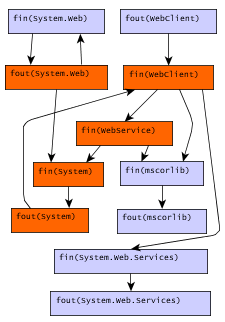

| Current | v9 | v8 | v7 | v6 | v5 | v4 | v3 | v2 | v1 | All | About |
Module Tier
The module tier uses the set of data flow paths found at the abstract component tier to construct a data flow graph that shows the data flow relationships between formal input and formal output parameters passed between modules. The graph is generated using the one-to-many table that was populated during generalization which conveys the module data flow paths that were generalized by the set of qualified component data flow paths. For this particular example, nearly all of the module data flow paths were qualified as potentially being involved in a reachable path between the source and sink flow descriptor. The graph that is generated as a result is shown in figure 15.
 |
Using this graph, the
 algorithm is again employed to find paths between the source and sink flow descriptor at the module tier. In this case, only the edges between the nodes highlighted in dark orange are found to be involved in reachable paths between fout(System.Web) and fin(System). The important thing to note is that even at the module tier, a data flow path is illustrated between fin(WebClient) and fin(WebService). This will be a trend that will continue to each more specific generalization tier.
algorithm is again employed to find paths between the source and sink flow descriptor at the module tier. In this case, only the edges between the nodes highlighted in dark orange are found to be involved in reachable paths between fout(System.Web) and fin(System). The important thing to note is that even at the module tier, a data flow path is illustrated between fin(WebClient) and fin(WebService). This will be a trend that will continue to each more specific generalization tier.